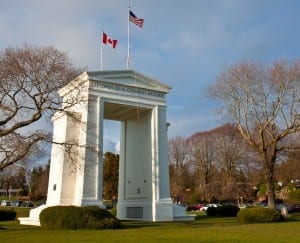Canada and the right wing illusion

Republicans waste their love on us.
Author: Liam Fitz-Gerald
It’s as if hell has frozen over.
In the last two weeks, American conservatives have been saying nice things about Canada. Several conservative commentators want the United States to be more like Canada, with phrases like “far more business-friendly tax jurisdiction” and “historic move toward open markets and economic growth” (because apparently Canada was an oppressive, authoritarian, communistic hellhole at one point) permeating their op-ed articles. John Fund, a conservative writer who described Canada formerly as America’s “more socialist and… poorer neighbour to the north,” wrote a Wall Street Journal article recently saying the Canucks had learned from their reckless public spending ways and have prospered over the last two decades via austerity, a much lower corporate taxation rate (top combined provincial/federal rate 25per cent in Canada versus close to 40 per cent in the US), and plans to dismantle tariffs. These conservatives portray American business as drowning in taxation and grabbing the lifeline of lower corporate taxation offered by other countries, including Canada. Conservatives use the latest Tim Hortons-Burger King deal as an example of this, and liberal Democrats should embrace, rather than condemn, a much lower corporate tax rate. Moreover, the Canadian Tax-Free Savings Account, which allows individuals to invest a portion of their money without fear of Revenue Canada taxing it, has caught the attention of American conservatives who praise its flexibility. All of this conservative fawning over Canada might cause one to ponder if the country has become more right wing.
The answer is ultimately yes and no. Certainly, Canadian policies have trended rightward both economically and politically since the 1980s. Economically, federal corporate taxes have fallen from a high of 41per cent in 1960 to the present 15 per cent. Nationally, the North American Free Trade Agreement was implemented in 1994, and its effects have polarized pundits on both sides of the spectrum. Leaders across all jurisdictions, from Jean Chretien and Paul Martin federally to Roy Romonow here in Saskatchewan, embarked on massive spending cuts and austerity in the 1990s. Moreover, parties on the left have moved more to the right themselves. The NDP under Thomas Mulcair has voiced interest in supporting free trade deals with countries like Jordan, Brazil, India and South Africa. Much to the disappointment of many New Democrats, the party has also been silent on NAFTA’s future, a position they once spoke vigorously on re-negotiating or leaving all together. The debate on the party being a “socialist” was also polarizing within the party as the word was voted out of references in its constitution. The Liberals are a much different party to characterize as they’ve leaned left some years and to the right on others, but under Justin Trudeau, they clearly lean right economically on issues such as free trade and taxing corporations.
However, Canadians themselves are more difficult to characterize then the policies of their governments and political parties. A poll conducted earlier in the summer asked sampled Canadians to choose objects that symbolized “Canadian values,” and ultimately, unity. Twenty-two per cent said universal health care – clearly something not fawned over by American conservatives – which beat hockey (11 per cent) and came in second behind the Charter of Rights and Freedoms. A similar poll from 2012 showed that 94 per cent of Canadians surveyed believed universal health care was “an important source of collective pride.” No political party currently in the House of Commons would support dismantling of the public health care system for an American-style system.
Furthermore, despite the rightward trend of Canada’s left-leaning political parties, it’s important to note that many Canadians still perceive them as the left or alternative to the right. This can be inferred from the results of the 2011 election. While 39.5 per cent of Canadian voters supported the unapologetically right-wing party, 55.5 per cent voted for parties, including the separatist Bloc Quebecois, they recognized as either left wing or centrist. The implication was that they’d have some leftist policies despite the fact that they moved to the right. Yet, many Canadians still recognized them as an alternative to the right and voted for them precisely because they saw them as just that. In Saskatchewan alone, despite winning no seats, a third of voters cast ballots for the NDP.
So, if Canada has become more right wing as a nation, why is universal health care seen as a unifying symbol? Why did more than half of Canadians vote for parties they saw as left or center left? The answer is that despite policy moves to the right, the Canadian polity remains much more ambiguous then the characterizations they hear about their country.










